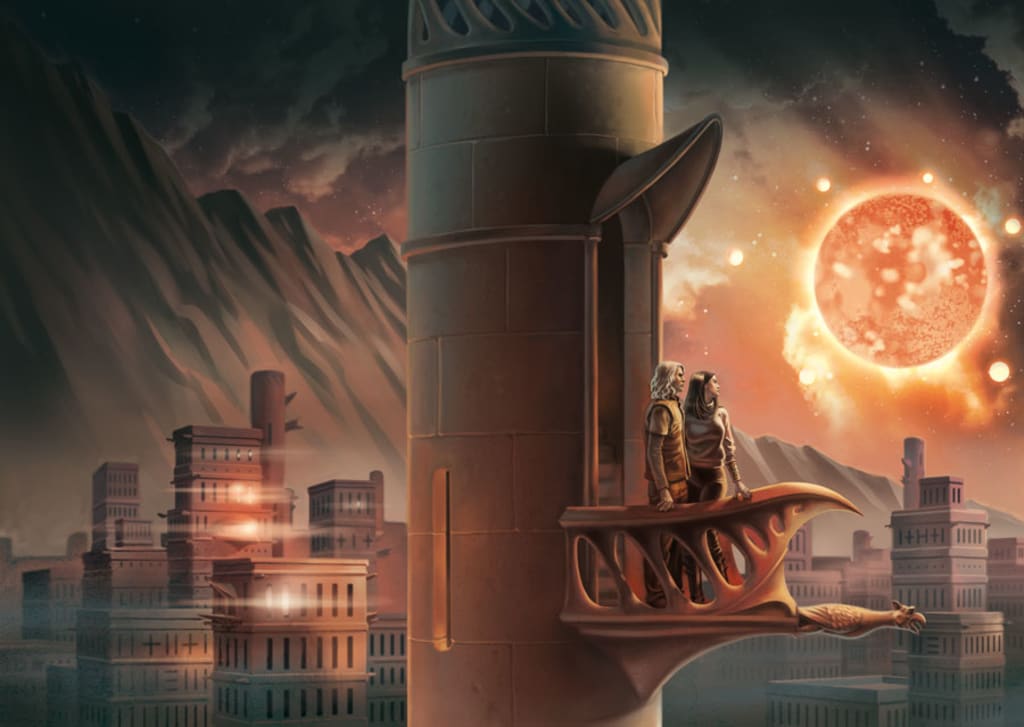Top Dying Earth Science Fiction Books
Though the origins of dying Earth science fiction books remount back to the Romantic Era, its true shape took form much more recently, in the 20th century.

A sub-genre of both fantasy and science fiction, the concept of a dying earth has been around for a while. Though its first origins remount back to the Romantic Era, its true shape took form much more recently, in the 20th century. Since then, it has been explored by several authors and brought forth books that are true masterpieces of the science fantasy genre and that are hugely influential to this day.
Dying Earth books differ from apocalyptic and dystopian fiction, for they do not bring the end with a sudden, tragic catastrophe. Instead, they play around the concept of a slow exhaustion, in which life shrinks from tiredness and the sun slowly fades in a decrepit universe. Though sometimes melancholic due to themes it explores regarding loneliness, entropy, and death, dying Earth books are still able to amaze readers with their unique, astonishing scenarios and intriguing plots.
Books that explore the dying Earth thematic tend to focus on the setting, most of the times an Earth vastly different from what we know today, and are set in a very distant future, where magic and technology are intertwined and sometimes challenge the laws of physics.
This 1895 science fiction novel popularized not only the concept of time travel and of a time machine, but it’s also considered one of the main roots of the dying Earth sub-genre, since it presents a futuristic earth that went back to a more primitive form.
In the book, we follow the story of an english inventor known simply as “The Time Traveller,” who upon discovering that time is nothing but the fourth dimension, is able to build a machine to travel through it. Making use of the machine, he travels to the far future, meeting the posterity of mankind deeply transformed. He also makes several short excursions throughout time, each deeper into the future, seeing the last survivors of an earth progressively dying.
In 1950, the dying Earth sub-genre finally had a name with the publishing of Jack Vance’s acclaimed The Dying Earth series.
It consists of four original books, set in a far future Earth, with a fading, dimming sun in the sky. The setting is full with ruins of decayed civilizations, humanity is shrinking and the few left inhabit these structures long lost. Many make use of technology from long ago, that they can no longer replicate nor understand fully and is somehow related to magic.
It influenced Dungeons and Dragon’s creators Gary Gygax and Dave Arneson, Gene Wolfe, who later wrote The Book of the New Sun series, George Martin and also M. Harrison, author of the Viriconium series.
Set in a far distant future Earth, this dying Earth book classic is composed of five short stories that present Earth millions of years in the future, when the Sun fills half of the sky and is in a locked rotation with Earth. Due to that, one side of the planet is home to a frenzied tropical jungle in an everlasting day. In Hothouse, humans are a fifth of their current size and on the brink of extinction, being constantly threatened by giant insects and by plants that are at the top of the food chain, for many are carnivorous and some have evolved eyes. Also, the moon has a breathable atmosphere and is connected to the Earth by cobwebs spun by spider-like plants. With all that, it’s no surprise Hothouse was awarded the 1962 Best Short Fiction Hugo Award.
Influenced by Jack Vance’s The Dying Earth series, The Book of the New Sun is considered, alongside The Lord of the Rings, as one of the greatest and most influential epic fantasy books of all time, called by the NYT “a major work of the 20th century.”
It’s a four book epic fantasy series, set a million years in the future, where all culture mankind produced was long forgotten. The first book of the series, The Shadow of the Torturer, introduces Severian, a torturer who is eventually exiled after falling in love with Thecla, one of his victims. What follows is one of the most acclaimed dying Earth books ever written. In this tetralogy, the Sun is dimming and the Earth is cooling. Obscure powers and events take place as the series present a first-person narrative laced with biblical and mythical imagery that requires multiple reads to be done justice. It is praised by authors such as George Martin, Neil Gaiman, Abercrombie, and others, and it is a must readers for lovers of science fiction and of dying earth books.
Published in 1977, Dying of the Light is George R. R. Martin’s first novel. It takes place in the fictional rogue planet of Worlorn, during the time the planet was moving away from the red giant star that allowed life to develop in the first place. As Worlorn approaches a dark and cold region of space, inhabitable for life, the light dims and George Martin’s habit of killing of characters is as present as it is in the Song of Ice and Fire series the author is most known for. Dying of The Light was nominated in 1978 for Hugo Award Best Novel and in 1979 for the British Fantasy Award and stands to this day as a top dying Earth book.
Published in 1979, Dark is the Sun is a stand alone novel set 15 billion years in the future, in an universe heading towards its end. With the Sun long dead and in a low point of intellect, Earth’s evolved species are unaware of the fact the Big Crunch of the universe is close.
In Dark is the Sun, every form of life has a sentient representative, including the standard animal, but also mineral and plant. The pairing of humans, for instance, occurs with the use of “Soul Eggs,” which are given shortly after birth and worn around the neck as a collar that decides whether or not a mate is proper for marriage.
The book begins with the human protagonist, Deyv, forced to leave his tribe after not being able to find a mate. In the hopes of finding someone in a distant tribe, Deyv has his “Soul Egg” stolen by a fox-like being named Yawtl, and after meeting other victims of the thief he sets out on a quest to recover his “Soul Egg,” clueless about the fact he embarked on a much larger journey.
This 2000 edition reunites all that was written by Harrison regarding the surreal, end of times, sometimes name changing city of Viriconium. This strange city sits on the ruins of an advanced, ancient civilization no one remembers, but whose influence is all over the world. This omnibus contains three novels and all the seven short stories, and it also counts with an introduction by Neil Gaiman, a great admirer of Harrison’s work.
Said to be the last inhabited continent of Earth, Zothique is set in a far future Earth, a moment in which our current continents no longer exist and have rearranged themselves. The “Zothique cycle” contains 16 short stories and a poem that were originally published in pulp magazines such as Weird Tales, known for featuring Lovecraft, and were later recollected and put in a single book. It presents a stepping point in the dying earth sub-genre and is cited by Jack Vance as one of his influences for The Dying Earth series he wrote.
Earthchild tells the story of Reee, a little girl who happens to be the last human being on Earth, who is taken by the enigmatic Emeroo, who fights against a protoplasmic, extraterrestrial ocean known simply as Indigo, spreads through the planet and devours anything in its path. The flora and fauna are either alien or deeply changed, and reminds readers of the anime Nausicaä. Earthchild belongs to the strange sci-fi sub-genre and it’s an unique dying Earth book that deserves a read by lovers of weird sci-fi.
This book is the first of Mark Charan Newton’s series Legends of the Red Sun. Though published in 2009, it takes inspiration from the classics of the Golden Era in which the settings tended to be the focus of the novel. In it, a new ice age is approaching, making thousands seek refuge in the ancient city of Villjamur. The city, however, is already crowded and incapable of giving shelter. The feeling of panic increases when the Emperor commits suicide without leaving a male heir and what follows is one of the most unique and intriguing works of recent speculative fiction and fantasy.
About the Creator
Stephanie Gladwell
Mother of two, educator of many. Teaches middle-school biology and chemistry. Always interested in exploring the unknown.






Comments
There are no comments for this story
Be the first to respond and start the conversation.